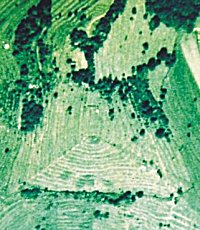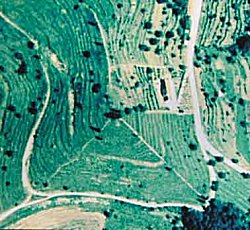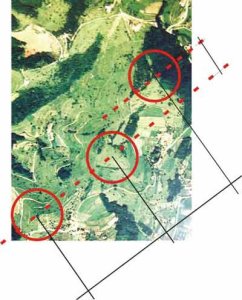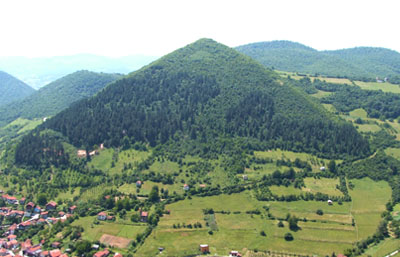Europe
England
 |
 |
Silbury Hill, Wiltshire has been carbon-dated at 2660 years BC, the same era as the Giza pyramids. It contains an estimated 340,000 cubic metres of chalk and earth, rising to a height of 39.6 metres. The base of the monument is 167m in diameter and it is perfectly round. The flat top is 30m across. It is part of a sequence of ancient sites in the area that are in alignment.
Despite its external appearance, this is actually a step pyramid, consisting of six, six metre high steps. The steps are walled with blocks of chalk, which easily deteriorates when left exposed. Consequently the builders preserved it, by covering it with earth and grass.
Excavations have revealed that it is not a burial mound.
Ireland
Near Drogheda, 45 kilometres north of Dublin on the east coast of Ireland, exists a concentration of standing stones, earthworks and passage graves. One of these, Newgrange, is the largest pre-historic structure in Ireland – and one of the oldest in the world. It dates back to 3250 BC.
It appears that we have drifted a long way from what might be defined as a pyramid. This egg-shaped mound of pebbles was once 14 metres in height with a diameter of 76 metres – hardly a massive monument compared to the largest pyramids, but still more than a days work. Like Silbury Hill it has no straight sides, and appears not to point to any cardinal directions, astronomical events or other structures. But if you venture inside, on the right day of the year, something magical happens.
Like the Egyptian pyramids, Newgrange contains a passage and chambers. These were constructed using giant slabs of stone, and then buried under a mound of pebbles. At the end of an 18 metre long, one metre wide passage are three chambers. The roof above them, although not required to withstand as much weight, uses the same corbelled design as the pyramids in Egypt (good pic here). At dawn on the midwinter solstice, the suns rays shine through a special window above the passage entrance, down the passage and illuminated the centre of the chambers. Precisely and deliberately. It isn’t so big, yet has much in common with other pyramids, especially those in Egypt. Is it’s location of any importance? We’ll check on that soon.
Canary Islands
The Canary Islands are a popular solution to the location of Atlantis, based on their location west of the Mediterranean, and their mountainous terrain – they are part of a volcanic archipelago with marine trenches as deep as 3,000 metres and mountains as high as 3,718 meters above sea level.
Archaeological findings suggest that the original inhabitants were Berbers who arrived from north Africa around 200 B.C. However, some early navigators reported the Canarians as being a race of tall, blond-haired, blue-eyed people, perhaps suggesting a northern European (or Atlantean) origin.
The Canary Islands were part of the route Columbus took to the Americas – he stopped in Tenerife for provisions in 1492.
 Dozens more photos here Dozens more photos here |
The six pyramids in Tenerife are quite small, like training exercises for those in Central America (one could almost suggest that it was Columbus that built them!). They are found near Guimar, a town on the eastern shore of Tenerife Island, about 40 kilometers (24 miles) south of Santa Cruz de Tenerife. Long dismissed by locals as mere piles of rubble, Norwegian explorer Thor Heyerdahl turned up and declared that they were indeed pyramids, not unlike those in Tucume, Peru that he had been studying.
Only a small study [i] has been of them to date, with these aspects being ascertained:
- There are six step pyramids, reaching a maximum height of about 12 metres. They are rubble-filled, with facings of black volcanic stone, and are the result of multiple episodes of construction.
- The main complex of three pyramids were found to be astronomically orientated with the sunset of the summer solstice. Stairways ascend from a level plaza to the top of each pyramid, where there is a flat summit platform covered with gravel. The stairways are all on the west wall, suggesting a ceremonial purpose, because someone ascending them on the morning of the solstice would be directly facing the rising sun.
Greece
There are 16 pyramids in Greece.
Ligourion
The Ligourion pyramid is found in northwestern Peloponnese, near the village of Ligourion, at the base of Mount Arachnaeum, not far from the site of ancient Epidaurus. Unfortunately it has almost totally disappeared, with its blocks being a handy source of masonry for the locals. Some of the sandstone blocks were used to construct the walls of a nearby church. Originally, its base measured 14 by 12 metres and using the method of thermoluminescence it has been dated to roughly 2100 B.C.
Hellenicon
 |
The Hellenikon pyramid is located near the village of Argolis. The Academy of Athens used thermoluminescence to determine an erection date of approximately 2720 BC, predating the earliest Egyptian pyramid by at least 100 years.
Chania Pyramid
 |
This pyramid is located in the south of the Chania area, Crete, at an altitude of 290 m above sea level. It is roughly 8.5 metres high with a circumference of 29 metres. The interior of the cone has a chamber, carved out of the solid rock, of approximately 2.2 by 2.1 by 1.4 metres.
Mount Taygetus
 |
There is a big question mark over whether this rock structure is manmade or a natural occurrence. Visitors have described how the texture of the rock surface suddenly becomes smooth, relative to that below, where the pyramid shape begins.
“The ancient Greeks believed that the sun drove in a chariot across the sky; hence the Rhodians, who worshipped the sun as their chief deity, annually dedicated a chariot and four horses to him, and flung them into the sea for his use. Doubtless they thought that after a year’s work his old horses and chariot would be worn out. From a like motive, probably, the idolatrous kings of Judah dedicated chariots and horses to the sun, and the Spartans, Persians, and Massagetae sacrificed horses to him. The Spartans performed the sacrifice on the top of Mount Taygetus, the beautiful range behind which they saw the great luminary set every night. It was as natural for the inhabitants of the valley of Sparta to do this as it was for the islanders of Rhodes to throw the chariot and horses into the sea, into which the sun seemed to them to sink at evening. For thus, whether on the mountain or in the sea, the fresh horses stood ready for the weary god where they would be most welcome, at the end of his day’s journey.” [ii]
Italy
 |
A relatively modern pyramid was built by Gaius Cestius in Rome, 1st century BC. Built of concrete and faced with marble, it has an interior tomb vault and is 35 metres high. It was constructed during the “Cleopatra craze” in architecture that swept across Rome at the time.
Montevecchia (= Old Mount in English)
Discovered only recently (from the air), in the north of Italy, 40 kn from Milan, are three pyramids, dating back to 3,000BC, and in the same alignment as Giza and Orion. The tallest is 150 metres in height, and beneath the earth are stone buildings, yet to be excavated. Alternatively, they could just be terraced hills, with stone support structures…
 |
 |
 |
|
More here (in Czech), and here (in Italian), and here or here (in English)
Others
Astana, Kazakhstan
Kazakhstan’s capital city of Astana is adding an iconic structure to its cityscape. World-renowned architect Lord Norman Foster has designed a “Palace of Peace,” a glass pyramid with a 62-meter base, at President Nursultan Nazarbayev’s behest. The building, scheduled for completion in the summer of 2006, is designed to serve as a symbol of inter-ethnic harmony in Kazakhstan.
Bosnian Pyramid of the Sun
Many experts have stated that it is not man-made. A few experts say it is. Located at the town of Visoko, northwest of Sarajevo, the 213 metre hill, upon which the Old town of Visoki was once sited, is roughly pyramid-shaped. More at Wikipedia, and the “official” site.


